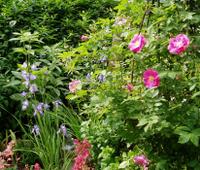Now's the time to get our gardens ready for the long-awaited days of sunlight and warmth. Summer will be here before we know it and the plants will suffer if we don't do our work now when the days are long and temperate, the nights cool, and the rainfall abundant. It's time to get out the trimmers, the lopers, the fork and spade, plus all the stamina we can muster!
Evaluate
The beginning of the garden year is an excellent time to evaluate what did and did not work in your garden design. As you work your way through the garden readying it for summer, review what garden changes delighted or depressed you last year.
Be Honest and Bold
Sometimes, we need to acknowledge that a design failed. Yes, it looked great on paper and our mind's eye thought it beautiful, but -- in reality, aka in the garden -- it was a flop. Some plants didn't thrive or they weren't good neighbors, or you realize that you consistently hurried past them, trying to ignore the fact that something was just plain wrong. Be honest. There's no point in rationalizing our mistakes. Be bold. Remove plants that are miserable, bullies, or that offend. They might do beautifully elsewhere -- perhaps in a self-contained area or in someone else's garden where they'll look smashing and thrive!
Divide, Replant, Remove
It's time to decide (and make notes about) what you want more of and what you want to eliminate. For example:
Which of the late Summer and Fall bloomers will you divide and replant now? If certain plants are thriving, encourage them. Divide and transplant them. Give them more space and create a stunning swath within the garden. If you have enough plant material and if you love the plant enough, consider making a solo garden where they are the stars.
Which of the late Spring and early Summer bloomers will you divide in the Fall? Add a small, semi-hidden marker so you won't forget that they'll need attention later in the season.
Which plants will you eliminate and give to friends for their gardens? Dig them out, pop them in planters, and send them to their new homes.
Are there plants that you want to add to your garden? Do you really have space for them? If so, get them and enjoy the new additions. But, if space is at a premium, either forgo the purchase or put them in pots where you can enjoy their beauty without compromising the garden's design.
Refresh the Gardens
To prepare the gardens for the drier, hotter New England Summer:
Remove all garden debris, dead foliage, and weeds
Gently aerate the soil
Add lime and a form of nutrients
Provide deep watering
Top dress each bed with a layer of compost
Mulch the entire garden AFTER the seedlings have emerged.






